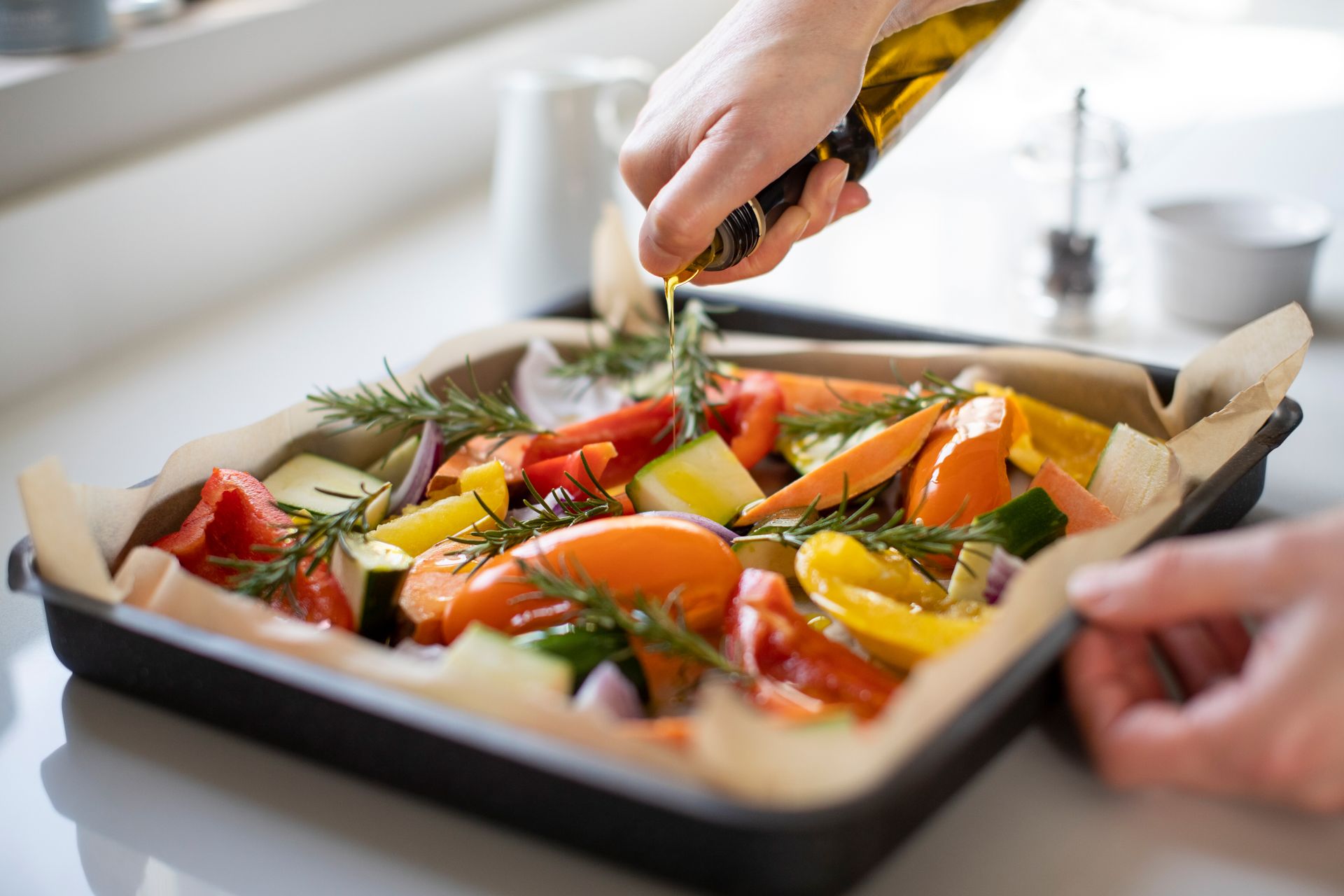Close Up Of Seasoning Tray Of Vegetables For Roasting With Olive OilContinue reading Close Up Of Seasoning Tray Of Vegetables For Roasting With Olive Oil
If you’re switching to a heart-healthy lifestyle, you might have picked up a bottle of good ole’ olive oil. Now you’re wondering what to do to get those heart-healthy benefits you’ve been reading up on. If this sounds like you, we’ve got some ideas. Keep reading to see how our nutritionist recommends using olive oil in a heart-healthy meal plan.
The role of olive oil in a heart-healthy diet
Olive oil is a type of oil made from olives. It yields a liquid rich in monounsaturated fats, antioxidants, and polyphenols – all of which benefit the health of your heart.
According to the United States Dietary Guidelines, dietary fats should make up 20-35% of your total daily calories. These percentages look different in a ketogenic or low carbohydrate diet, as your fat consumption will be closer to 70-80% of your total daily calories.
One tablespoon contains 120 calories and 14 grams of total fat. Of that total fat, 1.9 grams are saturated, 1.5 grams are polyunsaturated, and 9.8 grams are monounsaturated. Because most of the fat comes from monounsaturated, this oil can be your go-to for a heart-healthy lifestyle.
While there can be discrepancies when labeling a food as healthy, most organizations appear unified in classifying olive oil as heart-healthy.
Scientific Benefits of Olive Oil
A study published in the American Clinical Journal of Nutrition found that replacing saturated fats with unsaturated fats helps reduce blood pressure readings. These findings were negated if the overall fat intake exceeded 47% of total daily calories.
The Verdict: Try changing the type of fat you eat rather than increasing overall consumption.
Another study published in the Journal of the American College of Cardiology found that individuals with a higher olive oil intake had a 14% lower risk of Cardiovascular Disease and an 18% lower risk of Congestive Heart Disease. There was no impact seen on stroke risk.
The Verdict: Aim to consume at least 0.5 Tbsp of olive oil daily as part of a heart-healthy lifestyle.
How to substitute olive oil for butter in cooking
The Dietary Guidelines for Americans estimate that 5% of saturated fats come naturally from healthy whole food choices like lean meat, poultry, eggs, nuts and seeds, grains, and oils. The other 5% likely comes from added saturated fats like a store-bought bakery muffin. It might also come from cooking with butter, lard, or palm oil, labeled as saturated fats.
Are you tempted to cut out the fat completely? You can, but fats supply key components to a recipe, like flavor, texture, juiciness, and tenderness. Fats also help prevent foods from sticking to the pan and add crucial flakiness in baking.
Our vote is for a healthy swap when it feels right, and here’s how to do it. Substitute three-quarters of the butter in a recipe with olive oil. So, in a recipe that calls for 8 tablespoons of butter, use 6 tablespoons of olive oil instead.
This healthy swap works great in sauteeing, roasting, pasta dishes, and some baked goods.
5 Heart-Healthy Recipes to Get Started Using Olive Oil
Three Additional Recipes to Try:
- https://www.californiaoliveranch.com/recipes/white-bean-soup-with-winter-greens
- https://www.epicurious.com/recipes/food/views/slow-cooked-collard-greens-in-olive-oil
- https://www.themediterraneandish.com/baked-white-fish-recipe/
The Bottom Line
Olive oil is widely accepted as a heart-healthy oil due to its monounsaturated fats, polyphenols, and antioxidants. Try using it in your meal planning and recipe creations.
What’s your favorite way to use olive oil? Comment below to help others learn and get started using this heart-healthy oil.

